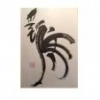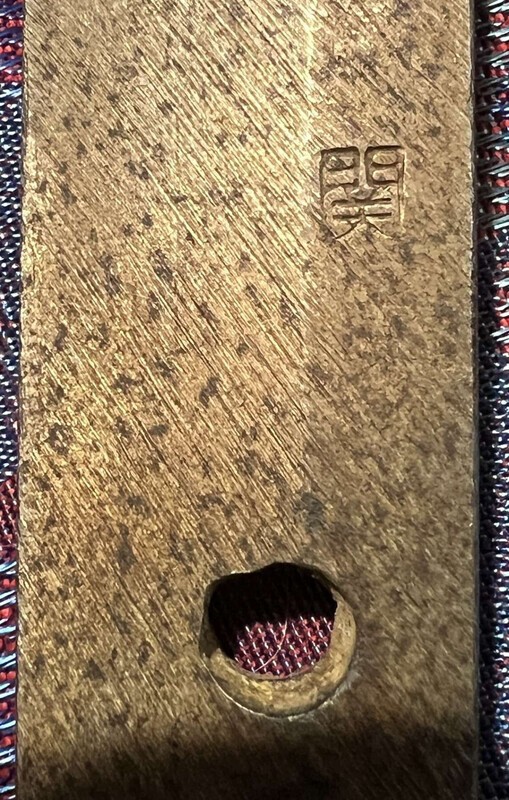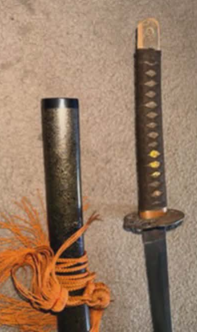-
Posts
939 -
Joined
-
Last visited
-
Days Won
15
Content Type
Profiles
Forums
Events
Store
Downloads
Gallery
Everything posted by mecox
-
TOSHICHIKA (敏周), real name Yamada Shūzō (山田週三), born May 28 (Meiji 28) 1895, from Seki ,registered as Seki smith Showa 17 (1942) June 28. was guntō smith and died February 20th 1973
-

Help Translating a Japanese Katana
mecox replied to LightningFox0124's topic in Translation Assistance
@LightningFox0124 Tyler, your sword would not be made of traditional iron or methods, but be a semi-machine made using a "western" style steel, but likely still well made. Its a bit confusing as there are several wartime Kanetsugu. But yours looks like Maekawa Genichi. The attached paper from NMB Downloads gives the context of his work, with examples and also shows the variations in mei and signature style. Also demonstrates some of the difficulties to determine the smith. As a note, yours has 2 holes in nakago, suggesting a remount. What are the mounts? -
@cookiemonstah47 Khalid, about your top blade (below) I have not had much luck. Upper kanji is rusted but it looks to me like: 紀伊國綱廣 "Kii no Kuni Tsunahiro" but cant find him. However, there are similarities to others like " Kii no Kuni Yasuhiro" but its only guessing.
-
Khalid, no.2 katana-mei, looks to be XXX Minamoto Norihiro (with old "hiro" 廣 noted by Jussi. Possibly is Sagami no Kami (from Sesko): NORIHIRO (則広), Jōkyō (貞享, 1684-1688), Settsu – “Niwa Sagami no Kami Minamoto Norihiro” (丹羽相模守源 則広), “Sagami no Kami Minamoto Norihiro” (相模守源則広), real name Niwa Den´emon (丹羽伝右衛門), he came originally from Kii province and belonged to the Ishidō school, dense ko-itame, hiro-suguha or chōji
-
Chris, that sori is interesting. I wonder if it is this smith (or related) in Sesko list: NAGAYUKI (長行), Tenshō (天正, 1573-1592), Bungo – “Hōshū-jū Fujiwara Nagayuki” (豊州住藤原長行), “Fujiwara Nagayuki” (藤原長行), Taira-Takada school, mostly suguha
-

Please help me identify this sword
mecox replied to TheTinkerBard's topic in Military Swords of Japan
Anton, 塚原兼次 - Kanetsugu Tsukahara (born 1919) is well documented. Sesko: KANETSUGU (兼次), Shōwa (昭和, 1926-1989), Gifu – “Kanetsugu” (兼次), real name Tsukahara Tarō (塚原太郎), born January 25th 1919, he worked as rikugun-jumei-tōshō and died on July 30th 1978, jōkō no retsu (Akihide), Fourth Seat at the 6th Shinsaku Nihontō Denrankai (新作日本刀展覧会, 1941). Seki registration: registered on Taisho 8 (1939) October 20. Uchiyama (1969): Kojima KANEMICHI forge: (1) Asano KANEZANE (2) Takasaki KANESHIGE (3) Kuriki KANEMASA (4) Tsukahara KANETSUGU (5) Miwa KANETOMO (6) Takeyama YOSHINAO. Dai Nippon Meikan (1942): Seki Kyoshin Sha (Seki) p.127: (Swordsmiths: Kojima Kanemichi, Kojima Kanenori, Takeyama Yoshinao, Miwa Kanetomo, Fujii Kanefuji, Kurimoto Kanemasa, Tsukahara Kanetsugu, Kato Kaneharu, Matsumoto Yoshinori) . Kojima Kanemichi Mon: Kanetsugu Tsukahara is listed (also note there is a Kanetsugu Maegawa born 1904, of same kanji). There is no indication of a mix up with name Tsukahara Noritsugu. As another item, I did find a Seki smith in Sesko who is not listed in Seki registration, and I did not hvae: HIDEYASU (秀安), Shōwa (昭和, 1926-1989), Gifu – “Seki-jū Hideyasu kore o saku” (関住秀安作之), real name Tsukahara Yasuo (塚原安男), born 1929, student of Tanaka Kanehide (田中兼秀) -

Please help me identify this sword
mecox replied to TheTinkerBard's topic in Military Swords of Japan
Anton, your sword reads "Noshu ju Tsukahara Noritsugu saku" 濃州住塚原則次作. There is no smith of that name in the WW2 Seki registration (but often smiths are omitted/not included). Sesko lists: NORITSUGU (則次), Aichi – “Noritsugu” (則次), “Fujiwara Noritsugu” (藤原則次), Jōko no Jōi (Akihide, 1942) and Fifth Seat at the 6th Shinsaku Nihontō Denrankai (1941). He may have been in the Nakano Mon in Okazaki, Aichi. Not clear if they are the same (with family name of Tsukahara). Sometimes smiths crossed between these two prefectures. Needs a bit more work to determine. -

Sorry To Report
mecox replied to Grey Doffin's topic in Sword Shows, Events, Community News and Legislation Issues
Richard George: I used a number of his published tsuba photos, brilliant work, amazing clarity and detail even in difficult items such as Tempo tsuba. What a very sad and unfortunate loss. -
@EdWolf SUKEKUNI (祐国), real name Miwa Kazuo (三輪一雄), born Meiji 42 (1909) April 8. From Seki-machi, Nagasumi-cho, registered as a Seki smith Showa 16 (1941) March 29. Reported to be Rikugun Jumei Tosho. Has Seki stamps and yours has Sakura/Gifu. Worked as guntō smith who worked through the war. Example: JSI-Stein. Seki stamp.
-
The mei being considered is 清宜 “Kiyonobu”, which can also be read as “Kiyonori”. There is also “nobu” and “nori” as 宣. Reported information on WW2 Kiyonobu: his real name was Nagamura Matsuichi (長村 松市) and he was born Meiji 34 (1901) April 10. (Sometimes referred to as “Osamura”). He was from Gifu Prefecture and registered as a Seki smith on Showa 16 (1941) April 30 (just turned 40) and was living in Kamo-gun, Tahara-mura, Osugi . He is not in the 1940 list of Seki Token Kaji Association. He is listed as a Rikugun Jumei Tosho, but he is not listed in the 1942 Bazuke of Kurihara Hikosaburo, or in the large commercial Dai Nihon Token Meikan of 1942. Nor is he in the 1941 Shinsakuto Exhibition. (He is not listed in Sesko). However, he was relatively productive during the war years. Of examples found, all blades are katana-mei, most have sujikai filing, but two have taka-no-ha (#1 with small stamp; #7 with small Seki stamp of Nagoya Arsenal 1943-1945). Other stamps: #4 small unknown stamp; #10 TAN is early war and better steel. Several mei are cut by specialists (nakirishi-mei) indicating bigger workshop: #6, 9, 10, 12; maybe also 4 and 5. Very little information on him, and more likely he was a blacksmith/metal worker, without formal training as swordsmith. Maybe early worked in smaller forges/shop, then later to Nagoya Arsenal. Some example descriptions of located oshigata (1) “Kiyonobu”, small unknown stamp, katana-mei, taka-no-ha yasurime strongly filed. “Nori” uncommon style. [Nazar, December, 2025, NMB] (2) “Nagamura Kiyonobu tsukuru kore”, katana-mei, sujikai? yasurime. [JSI, Stein] (3) “Kiyonobu”, tachi-mei, sujikai yasurime. Shingunto. [Griffin Militaria] (4) “Nagamura Kiyonobu”, small stamp, katana-mei, sujikai yasurime. [ikedaart] (5) “Nagamura Kiyonobu tsukuru”, katana-mei, sujikai yasurime. [Seiyudo] (6) “Noshu ju nin Nagamura Kiyonobu tsukuru kore” , NBTHK Hozon paper 2010 (Japanese seller read as “Kiyonori”). Katana-mei, sujikai yasurime. No date, no stamp. [e-sword.jp] (7) “Nagamura Kiyonobu”, katana-mei, taka-no-ha yasurime, small SEKI stamp of Nagoya Arsenal (1943-1945) [dwp,Dennis, December 2021, NMB] (8) “Noshu ju Nagamura Kiyonobu kore saku” very poorly cut, katana-mei, taka-no-ha yasirime roughly filed. Three punch marks (assembly marks?), later hole drilled (post-war?) (9) “Noshu Osugi ju Nagamura Kiyonobu saku” (living in Osugi in Mino/Gifu), well cut mei by specialist, katana-mei, sujikai yasurime. No date or stamp. [Jason Jcremer24, March, 2023, NMB] (10) “Nagamura Kiyonobu kitau kore”, TAN stamp, katana-mei, sujikai yaskuri-mei with kessho finish. [Slough, 2001, p.85] (11) “Nagamura Kiyonobu” SEKI stamp, katana-mei, yasurime not clear. Arsenal work. [Fuller & Gregory, 1983, #188] (12) “Nagamura Kiyonobu kitau kore”, katana-mei, sujikai yasurime. Early war. [Fuller & Gregory, 1983, #192] (13) no image: “Noshu Seki ju Kiyonobu saku”, SEKI stamp, date 1942. [Fuller & Gregory, 1983, #255]
-
Thank you Moriyama san. That is indeed very interesting. But surprising that a short tanto would be confiscated.
-
Not all clear. John and Jean look correct. Seems to be something like: Dai ichi X (Article 1 X) Showa 32 (1957) Dai 106 "na" Teppo nado (firearm extra, banned/restricted) Tomotsune sama. Possibly the owner. Yes needs an expert to read.
-

Katana surrendered by Admiral Fukudome?
mecox replied to Pincheck's topic in Military Swords of Japan
@pincheck Jack the kai gunto you posted is signed by Yoshishige (Komiyama). He was a Seki smith. Examples in NMB Downloads Naval swords part 2. -
@kiipu yes it does have a SHO stamp. He has others also, from early war period: YOSHINAO 義尚: real name Takeyama Tsutomu (武山勲). Born Meiji 39 (1906) August 17, older brother of Yoshitomi (義臣). Registered as Seki smith Showa 14 (1939) October 27 (age 33). Became Rikugun-jumei-tōshō. Died Showa 57 (1982) July 11. Akihide ranked in 1942: Jōkō no retsu (5/7). Second Seat at 6th Shinsakuto Exhibition 1941). Example mei: (“Seki Fujiwara Yoshinao”) (“Noshu Seki Takeyama Yoshinao saku” SHO), (“Seki Fujiwara Yoshinao saku” SHO), (“Seki Fujiwara Yoshinao saku kore”) (“Noshu ju Takeyama Yoshinao kin saku”) (“Noshu Seki ju nin Takeyama Yoshinao kin saku” SEKI).
-
This is the SEKI stamp, from mid-war period, which indicates not fully traditionally made. Example below shows it (from a May post, you can find by SEARCH):
-
A bit hard to say as need to have better pics. Can you take more detail of tsuka and fittings. Also pics of the blade. Considering his age he probably worked 1940 to 1945. Maybe employed by a sword shop or an arsenal. Most likely someone ordered a sword with these fittings. But not likely it went to war. Remember that soldiers had to buy their own swords, but certain civilians working with military could wear swords. Not likely he was "prominent" as no real records of training, and he does not appear to have entered any exhibitions/contests. It is probably a good example of its type but average. Cant comment on value without more pics. Others may. I added another example (1943) to previous post. ADDITION: I forgot that there is other posts on Kinmichi. Go to "Search" at top right on page and enter "Hibino"
-
Hello Pip, looks an interesting sword. It is by Kinmichi (can also be read as Kanemichi) and he was a smith in WW2. Your signature (mei) reads his name "Hibino Kinmichi". KINMICHI (金道), real name Hibino Ichiji (日比野一二), born May 6th Taisho 6 (1917), he worked as guntō smith and died August 20th 1945 age 28. He was a swordsmith in Gifu Prefecture, and registered as a Seki swordsmith in Showa 17 (1942) September 10. He came from Kamo-gun district to the east of Seki, and Oyama in Tomida-mura (village). It is interesting when he died, as Japan officially surrendered on 15 August 1945 (in some cases there is a relationship). The mounts are not military but civilian ("samurai style") but looks like the kashira (pommel) has come off the tsuka (hilt)? a bit hard to see in photo. The mei looks quite well cut . Do you see any stamps on the hilt? Here is another example of his work. (Stein JSI) At right another example, signed "Kinmichi" and has a date when made, looks to be September, 1943 (Showa 18) (from Meirin Sangyo)
-
Yes signed tachi mei, and yes what is length? Bruce may have it with this mei: 兼貞 (Kanesada) who were students of the 兼定 (Kanesada). Sometimes teacher and student used that shorter "Seki" it seems. Based on what I can see the following Sesko example is more likely: "KANESADA (兼貞), 4th gen., Daiei (大永, 1521-1528), Mino – “Izumi no Kami Fujiwara Kanesada” (和泉守藤原兼貞), “Seki-jū Kanesada saku” (関住兼貞作), “Kanesada” (兼貞), “Izumi no Kami Kanesada saku” (和泉守兼貞作), “Kanesada, Asamagadake ni oite kore o saku” (兼貞於朝熊岳是作, “made by Kanesada at Mt. Asama [Ise province]”), student of No-Sada, he followed his master to Ise where the latter had worked at some time in Yamada (山田) and Asamagatake (朝熊岳), it is said that he moved later to Echigo province, Sue-Seki style, robust sugata and often longer blades, standing-out itame mixed with masame, gunome mixed with chōji, frayed yakigashira, small tobiyaki, ryō-wazamono"
-
Kyle, mei reads: Touto ju Minamoto Yoshiharu saku. Touto = "Eastern Capiltal" = Tokyo. Minamoto is like a clan name. Signed on katana-mei. There is an example from Stein JSI:
-
why not show more pics as cant really comment on a distorted partial image
-
Dont know if this fits and he was a registered Seki smith: KAZUNORI (一則), Shōwa (昭和, 1926-1989), Gifu – “Kazunori” (一則), real name Kanematsu Kazuichi (兼松一市), born June 10th 1894, he worked as guntō smith and died December 9th 1944, posthumous Buddhist name Zendō Myōtoku (善導妙徳) (from Sesko). Member of Seki Token Kaji Assoc in 1940. Registered as a Seki smith in Showa 14 (1939) October 26. Oshigata from Gendai S/smith Index. Same in Slough 1942 with Seki stamp. Fuller & Gregory has same mei Seki stamp 1943.
-
-
@Ronald Aguirre Ron, mei looks to be: Noshu ju nin Murayama Kanetoshi kore saku kore (inhabitant of Noshu "Mino") 濃州住人村山兼俊之作 in artistic script. As noted by Conway date is Showa 14 (1939) February lucky day. The two kanji at right of date appear to be a name (of owner) maybe Mizu (cant read) 水 X. There is more info & pics in paper of "Japanese Swordsmiths GIFU 1937" in NMB Downloads ((top of page) 兼俊 Kanetoshi (村山 喜之一 Murayama Yoshinoichi) Born: Meiji 38 (1905) August 3; Registered as a Seki smith, Showa 14 (1939) October 8. In 1937 lived at Kamo-gun, Tomita-mura, Hanyu. History: trained under father Murayama Kaneyuki (#30). Died February 23, 1978. Independent from Showa 9 (1934) with tanrenjo at Kamo-gun, Kamono-mura. Summary: also trained under Niwa Kanematsu Kanenobu 兼信. In pre-war shinsakuto exhibitions won 3 Nyusen-sho, also Kinpai (Gold medal) and Daijin-sho (Ministers Award) 1940: 5th shinsakuto exhibition submitted long tachi (nagasa 115 cm) won recommendation. 1940: in tameshigiri section by Nakayama Hakudo his sword gained good review. 1941: 6th shinsakuto exhibition 2nd seat of 5. There was a father and two sons all registered in Seki in October, 1939 MURAYAMA Kaneyuki born 1884 Murayama Kanetoshi born 1905 Murayama Kaneshige born 1909 Example below is from Slough:




















